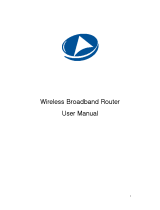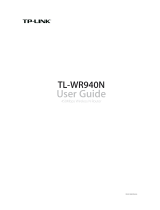
4.7.1 Basic Settings............................................................................................... 48
4.7.2 WPS ............................................................................................................. 50
4.7.3 Wireless Security..........................................................................................53
4.7.4 Wireless MAC Filtering ................................................................................. 57
4.7.5 Wireless Advanced ....................................................................................... 59
4.7.6 Wireless Statistics......................................................................................... 60
4.8 Guest Network .........................................................................................................61
4.9 DHCP ....................................................................................................................... 62
4.9.1 DHCP Settings .............................................................................................62
4.9.2 DHCP Clients List......................................................................................... 64
4.9.3 Address Reservation .................................................................................... 64
4.10 USB Settings............................................................................................................ 66
4.10.1 USB Mass Storage ....................................................................................... 66
4.10.2 User Accounts .............................................................................................. 66
4.10.3 Storage Sharing............................................................................................68
4.10.4 FTP Server ................................................................................................... 69
4.10.5 Media Server ................................................................................................71
4.10.6 Print Server................................................................................................... 73
4.11 NAT .......................................................................................................................... 73
4.12 Forwarding ............................................................................................................... 74
4.12.1 Virtual Servers .............................................................................................. 74
4.12.2 Port Triggering .............................................................................................. 76
4.12.3 DMZ..............................................................................................................78
4.12.4 UPnP ............................................................................................................ 78
4.13 Security ....................................................................................................................79
4.13.1 Basic Security............................................................................................... 80
4.13.2 Advanced Security........................................................................................ 81
4.13.3 Local Management .......................................................................................83
4.13.4 Remote Management ................................................................................... 84
4.14 Parent Control .......................................................................................................... 84
4.15 Access Control ......................................................................................................... 87
4.15.1 Rule ..............................................................................................................88
4.15.2 Host .............................................................................................................. 90
4.15.3 Target............................................................................................................ 92
4.15.4 Schedule....................................................................................................... 94
4.16 Advanced Routing .................................................................................................... 95
- II -





















